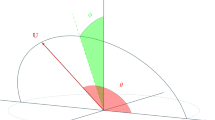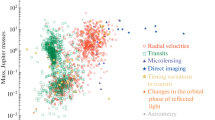Abstract
It is often thought that the exponential distance relations that can be found amongst the distances of the planets and of the satellites of Jupiter, Saturn, and Uranus, of the form a n = αβn, with a n being the semi-major axis of the n th body, can be similarly represented by sequences of sorted random numbers generated with some constraints corresponding to certain physical processes. We give in this paper some indications showing that pure chance or random processes only cannot explain the planetary and satellite distance distributions, in particular the exponential spacings, by comparing the distance relations of the real systems to these of planetary-like systems generated at random.
Exponential distance relations for the present planetary and satellites systems of Jupiter, Saturn and Uranus are described, considering the two cases without and with introduction of ‘holes’ for the large spacings observed in the sequences of bodies.
Random systems are created by generating distances at random following uniform, normal and exponential distributions, with no consideration for other orbital elements or masses as we are only interested in distance relations. Random systems without constraints are first compared to the real systems. In a following step, random systems with a corresponding number of bodies to that of the real systems and with the constraint of having a number of large spacings equivalent to that of the real systems are investigated. In a later step, we impose on the generation process the additional constraint of the ‘closeness not too close’ condition, i.e. for the random systems to have distances between adjacent ‘bodies’ greater than critical attraction distances calculated by considering the present masses of the real main planets and satellites.
Comparisons of the regression coefficients means of the exponential distance relations of random systems to the characteristics of the real systems show that there are significant differences, in particular the coefficients β of the random systems are on average smaller than for the corresponding real systems, except for some particular cases which are shown not to be significant.
It is concluded that distance relations observed in the present real systems can not be compared to sequences of sorted random numbers. Furthermore, additional physical processes other than the ‘closeness not too close’, have to be considered to explain the observed distance relations and in particular the exponential spacings.
Article PDF
Similar content being viewed by others
Avoid common mistakes on your manuscript.
References
Ahrens, J. H. and Dieter, U.: 1972, Communications of the Assoc. for Computing Machinery 15, 873.
Aksnes, K.: 1985, in Szebehely, V. G. (ed.), Stability of the Solar System and its Minor Natural and Artificial Bodies, D. Reidel Publ. Co., Dordrecht, Holland, pp. 3–16.
Bailey, M. E.: 1983, Mon. Not. Roy. Astr. Soc. 204, 1185.
Bailey, N. T. J.: 1983, Statistical Method in Biology, Hodder and Stoughton Unibooks, London, pp. 146–160.
Basano, K. and Hugues, D. W.: 1979, Nuovo Cimento 2C, No. 5, 505.
Bowel, E., Gehrels, T., and Zellner, B.: 1982, in Gehrels T. (ed.), Asteroids, The University of Arizona Press, Tucson, Arizona, pp. 1108–1129.
Dermott, S. F.: 1972, in Reeves H. (ed.), On the Origin of the Solar System-Nice Symposium, CNRS, Paris, pp. 320–335.
Dermott, S. F.: 1973, Nature 244, 18.
Dole, S. H.: 1970, Icarus 13, 494.
Kennedy, W. J. Jr. and Gentle, J. E.: 1980, in Owen D. B. (ed.), Statisical Computing, Statistics: textbooks and monographs (vol. 33), Marcel Dekker, New York.
Kinderman, A. J. and Ramage, J. G.: 1976, Journal of the American Statistical Assoc. 71, 893–896.
Knuth, D. E.: 1969, The Art of Computer Programming, vol. 2: Semi-numerical Algorithms, Addison-Wesley, Reading, Massachusetts.
Lane, A. L., C. W. Hord, R. A., West, L. W., Esposito, K. E., Simmons, R. M., Nelson, B. D., Wallis, B. J., Burath, L. J., Horn, A. L., Graps and W. R. Pryor, Science 233, 65.
Lecar, M.: 1973, Nature 242, 318.
Levene, H. and Wolfowitz, J.: 1944, Annals of Mathematical Statistics 15, 58–69.
Levy, J.: 1979, in Les étoiles, le système solaire, Bureau des Longitudes, Gauthier-Villars, Bordas, Paris, 7–41.
Marsaglia, G.: 1964, Technometrics 6, 101.
Melchior, P.: 1947, Bull. de l'Acad. Royale de Belgique, Cl. des Sciences, 212–221.
Morrison, D., Cruikshank, D. P., and Burns, J. A.: 1977, in Burns J. A. (ed.), Planetary Satellites, The University of Arizona Press, Tucson, Arizona, pp. 3–17.
Nieto, M. M.: 1970, Astron. Astrophys. 8, 105.
Nieto, M. M.: 1972, The Titus-Bode Law of Planetary Distances: Its History and Theory, Pergamon Press, Oxford.
Pletser, V.: 1986, Earth, Moon, and Planets 36, 193.
Pletser, V.: 1987, Proc. of Comparative Planetology and Earth Sciences Workshop, CNES, Cepadues, Toulouse (in press).
Prentice, A. J. R.: 1984, Earth, Moon, and Planets 30, 209.
Reinsch, K. and Pakull, W.: 1986, Circular IAU, No. 4272 of 17 November 1986, Marsden B. G., Central Bureau for Astronomical Telegrams, S.A.O.
Stone, E. C. and Miner, E. D.: 1986, Science 233, 39.
Williams, J. G.: 1982, in Gehrels T. (ed.), Asteroids, The University of Arizona Press, Tucson, Arizona, pp. 1040–1963.
Author information
Authors and Affiliations
Rights and permissions
About this article
Cite this article
Pletser, V. Exponential distance relations in planetary-like systems generated at random. Earth Moon Planet 42, 1–18 (1988). https://doi.org/10.1007/BF00118035
Received:
Revised:
Issue Date:
DOI: https://doi.org/10.1007/BF00118035




